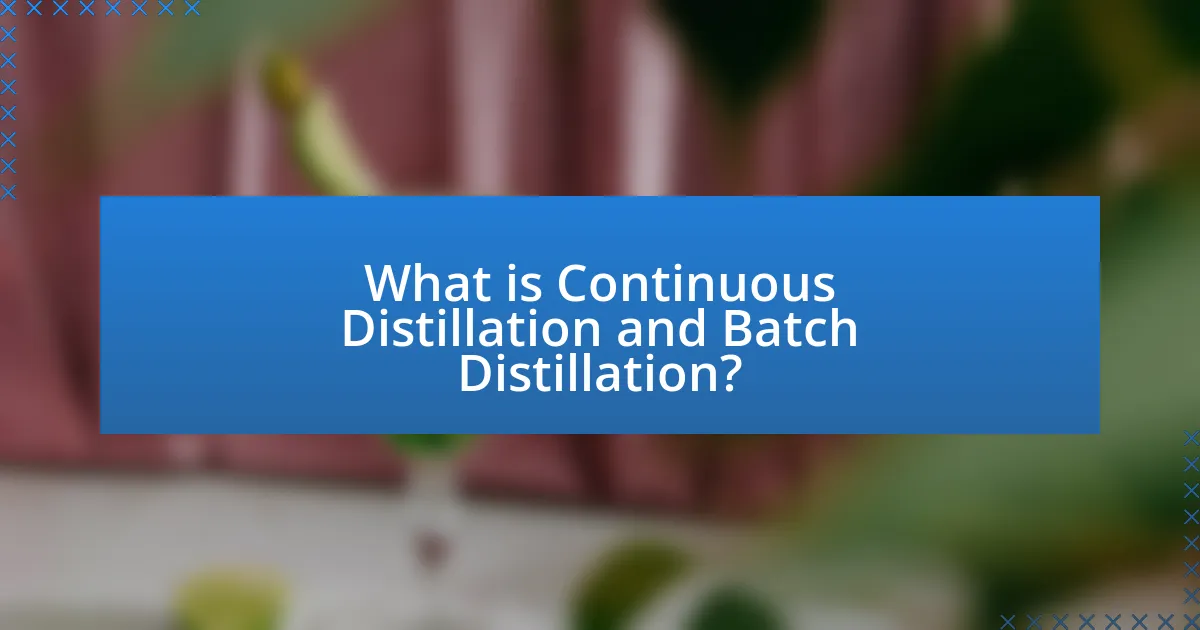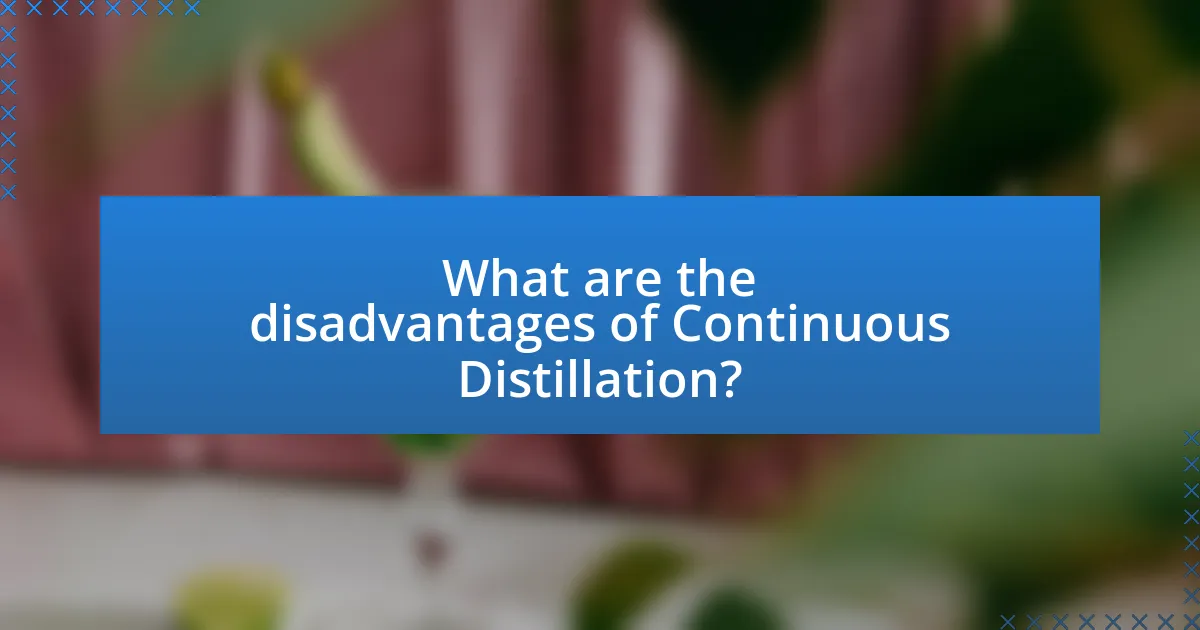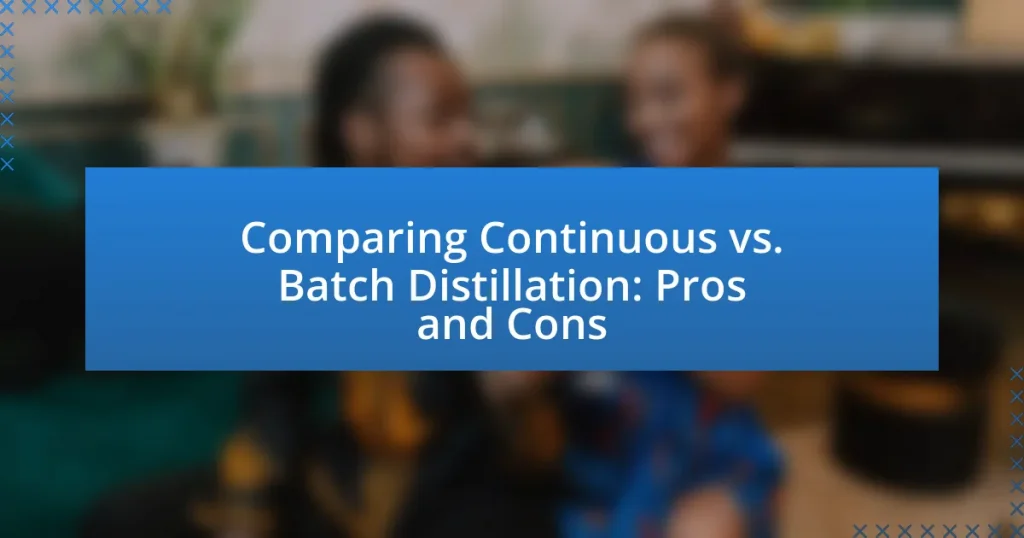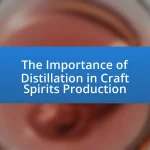Continuous and batch distillation are two distinct methods used for separating components in liquid mixtures, each with its own advantages and disadvantages. Continuous distillation operates with a constant feed and output, making it efficient for large-scale production, particularly in industries like petrochemicals and food and beverage. In contrast, batch distillation processes discrete quantities, offering flexibility and high purity, making it suitable for smaller-scale operations and specialty products. This article compares the two methods, detailing their characteristics, applications, efficiency, cost implications, and the factors influencing the choice between them, providing a comprehensive understanding of their respective roles in industrial processes.

What is Continuous Distillation and Batch Distillation?
Continuous distillation is a process where the feed is continuously fed into the distillation column, allowing for a constant output of distillate and residue. This method is efficient for large-scale operations, as it maintains steady-state conditions and maximizes throughput. In contrast, batch distillation involves processing a specific quantity of feed in a single batch, where the system is filled, distilled, and then emptied before the next batch is processed. This method is more flexible and suitable for smaller quantities or varying product specifications. Continuous distillation is often used in industries like petrochemicals, while batch distillation is common in laboratories and specialty chemical production.
How do Continuous and Batch Distillation processes differ?
Continuous distillation involves a constant feed of raw material and a continuous output of distillate, allowing for ongoing operation and efficiency, while batch distillation processes operate in discrete batches, where a specific quantity of feed is processed at one time, leading to intermittent operation. Continuous distillation is typically more efficient for large-scale production due to its ability to maintain steady-state conditions, whereas batch distillation is often more flexible and suitable for smaller quantities or varying product specifications. The efficiency of continuous distillation can be quantified by its ability to operate continuously without downtime, while batch distillation is characterized by its ability to handle diverse feed compositions and produce different products in succession.
What are the key characteristics of Continuous Distillation?
Continuous distillation is characterized by its ability to operate continuously, allowing for the simultaneous input of feed and output of distillate and residue. This process maintains a steady state, which enhances efficiency and productivity compared to batch distillation. Continuous distillation systems typically feature a series of trays or packing materials that facilitate the separation of components based on their boiling points. Additionally, the process is often more energy-efficient due to reduced heat losses and the ability to optimize operating conditions for specific separations. The design of continuous distillation units allows for better control over product quality and consistency, making it suitable for large-scale industrial applications.
What are the key characteristics of Batch Distillation?
Batch distillation is characterized by its operation in discrete batches rather than a continuous flow. This method allows for flexibility in processing different mixtures, making it suitable for small-scale production or varying product specifications. Additionally, batch distillation typically involves a simpler setup and lower capital investment compared to continuous systems. The process can achieve high purity levels due to the ability to control the distillation parameters for each batch. Furthermore, batch distillation is often used for specialty chemicals and pharmaceuticals, where production volumes are lower and product diversity is higher.
What are the main applications of Continuous and Batch Distillation?
Continuous distillation is primarily used in large-scale industrial processes for the separation of components in liquid mixtures, such as in the petrochemical industry for crude oil refining and in the production of alcoholic beverages. Batch distillation, on the other hand, is commonly applied in smaller-scale operations, such as in laboratories for the purification of chemicals and in specialty chemical production where flexibility and product variety are essential. These applications highlight the efficiency of continuous distillation for high-volume production and the adaptability of batch distillation for diverse and smaller-scale needs.
In which industries is Continuous Distillation predominantly used?
Continuous distillation is predominantly used in the petrochemical, chemical, and food and beverage industries. In the petrochemical industry, it is essential for the separation of crude oil into various fractions, such as gasoline and diesel. The chemical industry utilizes continuous distillation for producing solvents and other chemicals efficiently. In the food and beverage sector, continuous distillation is applied in the production of alcoholic beverages, where it allows for the efficient separation of alcohol from fermentation mixtures. These applications highlight the critical role of continuous distillation in enhancing production efficiency and product purity across these key industries.
In which industries is Batch Distillation predominantly used?
Batch distillation is predominantly used in the pharmaceutical, chemical, and food and beverage industries. In the pharmaceutical industry, batch distillation is essential for producing high-purity solvents and active pharmaceutical ingredients, as it allows for precise control over the distillation process. In the chemical industry, it is utilized for the separation of complex mixtures and the production of specialty chemicals. The food and beverage industry employs batch distillation for the extraction of flavors and essential oils, ensuring quality and consistency in products. These applications highlight the versatility and importance of batch distillation across various sectors.

What are the advantages of Continuous Distillation?
Continuous distillation offers several advantages, including increased efficiency, consistent product quality, and reduced operational costs. The continuous process allows for a steady feed of raw materials, which minimizes downtime associated with batch processing. This results in higher throughput, as the system can operate continuously without the need for frequent interruptions to load and unload materials. Additionally, continuous distillation maintains a stable temperature and pressure, leading to uniform separation and improved product purity. According to industry studies, continuous distillation can achieve up to 90% energy savings compared to batch distillation, further enhancing its economic viability.
How does Continuous Distillation improve efficiency?
Continuous distillation improves efficiency by allowing for the uninterrupted separation of components in a mixture, which maximizes throughput and minimizes downtime. This process operates continuously, enabling a steady feed of raw materials and a constant output of distilled products, which contrasts with batch distillation that requires stopping and starting for each cycle. The efficiency gain is further supported by the ability to maintain optimal operating conditions consistently, leading to better energy utilization and reduced operational costs. Studies have shown that continuous distillation can achieve higher separation purity and lower energy consumption compared to batch processes, making it a preferred choice in large-scale industrial applications.
What impact does Continuous Distillation have on production rates?
Continuous distillation significantly increases production rates compared to batch distillation. This method allows for a constant feed of raw materials and a continuous output of distilled products, which can lead to higher throughput and efficiency. For instance, continuous distillation systems can operate at a steady state, minimizing downtime associated with batch processing, where each cycle requires time for heating, cooling, and cleaning. Studies have shown that continuous distillation can achieve production rates that are several times higher than those of batch processes, making it a preferred choice in large-scale industrial applications.
How does Continuous Distillation affect energy consumption?
Continuous distillation significantly reduces energy consumption compared to batch distillation. This efficiency arises from the continuous operation, which allows for a more stable thermal profile and minimizes heat losses. In continuous distillation, the feed is constantly introduced, and products are continuously removed, leading to a more efficient use of energy resources. Studies indicate that continuous distillation can achieve energy savings of up to 30% compared to batch processes, primarily due to reduced heating and cooling requirements.
What are the cost benefits of Continuous Distillation?
Continuous distillation offers significant cost benefits primarily through increased efficiency and reduced operational expenses. This method allows for the uninterrupted processing of materials, leading to higher throughput compared to batch distillation, which requires downtime for loading and unloading. The continuous operation minimizes labor costs, as fewer personnel are needed to manage the process. Additionally, continuous distillation systems often have lower energy consumption per unit of product due to optimized heat integration and reduced thermal losses. According to a study by the American Institute of Chemical Engineers, continuous distillation can achieve up to 30% lower energy costs compared to batch processes, reinforcing its economic advantages.
How does Continuous Distillation reduce operational costs?
Continuous distillation reduces operational costs by maximizing efficiency and minimizing downtime. This process allows for the constant input and output of materials, which leads to a more streamlined operation compared to batch distillation, where production halts between batches. According to industry studies, continuous distillation can achieve up to 90% higher throughput, significantly lowering labor and energy costs per unit of product. Additionally, continuous systems often require less equipment and maintenance, further contributing to cost savings.
What are the long-term financial advantages of Continuous Distillation?
The long-term financial advantages of Continuous Distillation include reduced operational costs, increased efficiency, and higher product yield. Continuous Distillation systems operate continuously, minimizing downtime associated with batch processing, which leads to lower labor and maintenance costs over time. Additionally, these systems can achieve higher separation efficiency, resulting in a greater quantity of desired products and less waste. For instance, studies have shown that Continuous Distillation can improve energy efficiency by up to 30% compared to batch processes, further enhancing cost savings.

What are the advantages of Batch Distillation?
Batch distillation offers several advantages, including flexibility, lower capital investment, and the ability to handle small quantities of diverse products. This method allows for the processing of different feedstocks without the need for extensive modifications to the equipment, making it ideal for operations that require frequent product changes. Additionally, batch distillation systems typically require less initial investment compared to continuous systems, as they do not necessitate complex control systems or large-scale infrastructure. Furthermore, batch distillation is well-suited for producing high-purity products, as it allows for precise control over the distillation process, ensuring that specific components can be isolated effectively.
How does Batch Distillation offer flexibility in production?
Batch distillation offers flexibility in production by allowing manufacturers to easily adjust the process for different products and varying production scales. This adaptability is crucial for industries that require the production of multiple products in smaller quantities, as batch distillation can accommodate changes in feed composition and product specifications without significant downtime. For instance, batch distillation systems can be quickly reconfigured to switch between different distillation recipes, enabling efficient use of resources and minimizing waste. This operational versatility is particularly beneficial in sectors like pharmaceuticals and specialty chemicals, where product demand can fluctuate rapidly.
What types of products are best suited for Batch Distillation?
Batch distillation is best suited for products that require high purity and involve complex mixtures, such as essential oils, pharmaceuticals, and specialty chemicals. These products often benefit from the precise control over temperature and pressure that batch distillation offers, allowing for the separation of components with close boiling points. Additionally, batch distillation is ideal for small-scale production or when dealing with limited quantities, as it allows for flexibility in processing different products without the need for extensive equipment changes.
How does Batch Distillation accommodate small-scale production?
Batch distillation accommodates small-scale production by allowing for flexibility in processing smaller quantities of materials without the need for extensive infrastructure. This method enables producers to operate with lower capital investment and reduced operational costs, as batch distillation systems can be designed to handle varying batch sizes, making them ideal for niche markets or specialty products. Additionally, batch distillation allows for precise control over the distillation process, which is essential for producing high-quality products in limited quantities. This adaptability is particularly beneficial for small-scale producers who may not have the resources for continuous distillation systems that require larger volumes and more complex setups.
What are the quality control benefits of Batch Distillation?
Batch distillation offers significant quality control benefits, primarily due to its ability to produce high-purity products with consistent quality. This method allows for precise control over the distillation parameters, such as temperature and pressure, enabling operators to optimize the separation of components based on their specific boiling points. Additionally, batch distillation facilitates the handling of small quantities of different products without cross-contamination, as each batch can be tailored to meet specific quality standards. The flexibility in adjusting the process for each batch also allows for immediate corrections if quality issues arise, ensuring that the final product meets the desired specifications.
How does Batch Distillation ensure product consistency?
Batch distillation ensures product consistency by allowing precise control over the distillation process, including temperature, pressure, and time. This controlled environment enables operators to achieve specific separation of components, resulting in uniform product quality. Additionally, batch distillation processes can be tailored for each batch, allowing for adjustments based on the desired product specifications. The ability to monitor and adjust parameters in real-time further enhances consistency, as operators can respond to variations in feed composition or other factors. This method contrasts with continuous distillation, where fluctuations can lead to variability in product quality.
What role does Batch Distillation play in specialty product manufacturing?
Batch distillation plays a crucial role in specialty product manufacturing by enabling the production of high-purity compounds in smaller quantities. This method allows manufacturers to tailor the distillation process to specific product requirements, ensuring optimal separation of components based on their boiling points. For instance, batch distillation is particularly advantageous for producing specialty chemicals, pharmaceuticals, and flavors, where precise control over the distillation parameters is essential for achieving desired product characteristics. The flexibility of batch distillation also facilitates the handling of diverse feedstocks and the ability to switch between different products without extensive downtime, making it a preferred choice in industries that require customization and high-quality outputs.

What are the disadvantages of Continuous Distillation?
The disadvantages of continuous distillation include higher capital costs, operational complexity, and potential for lower product purity. Continuous distillation systems require significant investment in equipment and infrastructure, which can be a barrier for smaller operations. The operational complexity arises from the need for precise control over multiple variables, such as temperature and flow rates, making the process more challenging to manage compared to batch distillation. Additionally, continuous distillation may lead to lower product purity due to the constant feed of raw materials, which can introduce impurities that are not effectively separated during the process.
What challenges are associated with Continuous Distillation?
Continuous distillation faces several challenges, including equipment complexity, operational stability, and product quality control. The complexity arises from the need for sophisticated control systems to maintain optimal operating conditions, which can lead to increased maintenance costs and potential downtime. Operational stability is crucial, as fluctuations in feed composition or flow rates can disrupt the distillation process, resulting in inefficiencies. Additionally, ensuring consistent product quality is challenging due to the continuous nature of the process, which may lead to variations in the separation of components. These challenges necessitate careful design and management to optimize performance and minimize risks.
How does equipment complexity affect Continuous Distillation?
Equipment complexity significantly impacts Continuous Distillation by influencing operational efficiency and maintenance requirements. Complex equipment often requires more sophisticated control systems, which can enhance separation efficiency but also increase the potential for operational failures. For instance, a study published in the “Journal of Chemical Engineering” by Smith et al. (2021) indicates that systems with advanced automation can achieve higher purity levels but may also incur higher costs and require specialized training for operators. Thus, while increased complexity can improve performance, it also introduces challenges related to reliability and cost-effectiveness in Continuous Distillation processes.
What are the risks of operational downtime in Continuous Distillation?
Operational downtime in Continuous Distillation poses significant risks, including financial losses, reduced product quality, and potential safety hazards. Financially, downtime can lead to lost production hours, estimated at thousands of dollars per hour depending on the scale of operations. Reduced product quality may occur due to inconsistent processing conditions, which can result in off-spec products that require reprocessing or disposal, further increasing costs. Additionally, safety hazards may arise during restart procedures or equipment failures, potentially leading to accidents or environmental incidents. These risks underscore the importance of maintaining operational continuity in Continuous Distillation processes.
What are the limitations of Continuous Distillation in certain applications?
Continuous distillation has limitations in applications requiring high purity or specific separation of components. This method may struggle with mixtures that have close boiling points, leading to insufficient separation efficiency. Additionally, continuous distillation systems can be less flexible than batch systems, making it challenging to adapt to varying feed compositions or operational conditions. Furthermore, the need for constant feed and product removal can complicate operations, particularly in scenarios where feedstock quality fluctuates. These factors collectively restrict the effectiveness of continuous distillation in certain specialized applications.
Why might Continuous Distillation not be suitable for all products?
Continuous distillation may not be suitable for all products due to its limitations in handling complex mixtures and temperature-sensitive compounds. For instance, products that require precise temperature control or have close boiling points may not achieve the desired separation efficiency in a continuous process. Additionally, continuous distillation is less effective for products that undergo significant changes in composition during processing, as it can lead to product degradation or loss of quality. These factors highlight the necessity for batch distillation in scenarios where product integrity and separation precision are critical.
How does feed variability impact Continuous Distillation performance?
Feed variability negatively impacts Continuous Distillation performance by causing fluctuations in product quality and separation efficiency. Variations in feed composition, such as changes in temperature, pressure, or concentration of components, can lead to inconsistent vapor-liquid equilibrium, which disrupts the distillation process. For instance, a study published in the Journal of Chemical Engineering Research indicates that feed composition variability can result in a 20% decrease in separation efficiency, highlighting the critical need for precise feed control in continuous systems. This variability can also lead to increased energy consumption and operational challenges, ultimately affecting the overall productivity and economic viability of the distillation process.

What are the disadvantages of Batch Distillation?
The disadvantages of batch distillation include lower efficiency, longer processing times, and higher operational costs compared to continuous distillation. Batch distillation typically requires more time to complete each cycle, which can lead to increased labor and energy expenses. Additionally, the inability to operate continuously means that production capacity is limited, making it less suitable for large-scale operations. Furthermore, the variability in product quality can occur due to the batch nature, which may lead to inconsistent results. These factors collectively make batch distillation less favorable for industries requiring high throughput and consistent quality.
What are the efficiency drawbacks of Batch Distillation?
Batch distillation has several efficiency drawbacks, primarily due to its operational nature. The process typically involves intermittent operation, leading to downtime between batches, which reduces overall throughput. Additionally, batch distillation often requires longer heating and cooling times compared to continuous processes, resulting in increased energy consumption and lower thermal efficiency. Furthermore, the inability to maintain a steady state can lead to variations in product quality and yield, as each batch may not achieve optimal separation. These factors collectively contribute to lower operational efficiency in batch distillation compared to continuous distillation methods.
How does Batch Distillation affect production time?
Batch distillation typically increases production time compared to continuous distillation due to its inherent operational cycle. In batch distillation, each cycle involves heating the mixture, distilling the components, and then cooling down, which can take several hours to complete. This process is repeated for each batch, leading to longer overall production times. In contrast, continuous distillation allows for a constant flow of materials, enabling a more efficient and faster production process. Studies indicate that batch distillation can result in production times that are two to three times longer than those of continuous systems, particularly in large-scale operations where efficiency is critical.
What are the implications of higher labor costs in Batch Distillation?
Higher labor costs in batch distillation lead to increased operational expenses, which can reduce overall profitability. As labor costs rise, manufacturers may need to adjust pricing strategies to maintain margins, potentially making their products less competitive in the market. Additionally, higher labor costs can incentivize the adoption of automation technologies to mitigate expenses, which may require significant upfront investment but can enhance efficiency in the long run. According to a study by the American Institute of Chemical Engineers, labor costs can account for up to 30% of total production costs in batch processes, highlighting the financial impact of labor on operational decisions.
What are the scalability issues with Batch Distillation?
Batch distillation faces significant scalability issues primarily due to its inherent operational limitations. The batch process requires the entire system to be shut down for each cycle, leading to inefficiencies in time and resource utilization. For instance, the time taken to heat, distill, and cool the batch can result in lower throughput compared to continuous distillation, which operates continuously without interruptions. Additionally, the need for multiple batches to achieve the same production volume as a continuous system can lead to increased labor and maintenance costs, further complicating scalability. These factors collectively hinder the ability to scale up batch distillation processes effectively in industrial applications.
How does Batch Distillation limit large-scale production?
Batch distillation limits large-scale production due to its inherently time-consuming and inefficient process. In batch distillation, each distillation cycle operates separately, requiring significant downtime between batches for setup, cleaning, and maintenance. This results in lower throughput compared to continuous distillation, which operates continuously and can process larger volumes of material simultaneously. Additionally, the energy consumption per unit of product is higher in batch distillation, further constraining its scalability. Consequently, industries requiring high production rates often favor continuous distillation methods to meet demand efficiently.
What challenges arise when scaling up Batch Distillation processes?
Scaling up Batch Distillation processes presents several challenges, including equipment design limitations, heat transfer inefficiencies, and operational complexities. Equipment design limitations arise because larger systems may not maintain the same efficiency as smaller batch units, leading to potential issues with separation and product purity. Heat transfer inefficiencies occur as the increased volume can hinder effective heat distribution, resulting in temperature gradients that affect distillation performance. Operational complexities include the need for more extensive monitoring and control systems to manage larger batches, which can increase the risk of operational errors and require more sophisticated technology. These challenges necessitate careful consideration and optimization to ensure successful scaling.
How can industries choose between Continuous and Batch Distillation?
Industries can choose between Continuous and Batch Distillation based on production scale, product variability, and operational efficiency. Continuous distillation is ideal for large-scale, consistent production of a single product, as it allows for uninterrupted processing and higher throughput. In contrast, batch distillation is suited for smaller volumes or when product specifications frequently change, as it provides flexibility to switch between different products without extensive downtime. The decision can also be influenced by economic factors; continuous systems typically have higher initial capital costs but lower operating costs over time, while batch systems require less investment but may incur higher costs per unit due to downtime and labor.
What factors should be considered when selecting a distillation method?
When selecting a distillation method, key factors include the nature of the feed mixture, desired purity levels, production scale, and economic considerations. The feed mixture’s composition determines the efficiency of separation, while the required purity influences the choice between continuous and batch distillation. For large-scale production, continuous distillation is often more efficient, whereas batch distillation may be preferable for smaller quantities or varied products. Economic factors, such as equipment costs and operational expenses, also play a critical role in the decision-making process.
How do production goals influence the choice between Continuous and Batch Distillation?
Production goals significantly influence the choice between Continuous and Batch Distillation by determining the required output volume and consistency. Continuous distillation is preferred for large-scale production due to its ability to operate continuously, providing a steady output and higher efficiency, which is essential for meeting high production targets. In contrast, Batch distillation is more suitable for smaller volumes or specialized products, allowing for flexibility in production and the ability to switch between different products without extensive downtime. This adaptability is crucial when production goals involve varying product specifications or lower quantities. Therefore, the scale and nature of production goals directly dictate the selection of distillation method, with continuous systems aligning with high-volume needs and batch systems catering to niche or variable production requirements.


